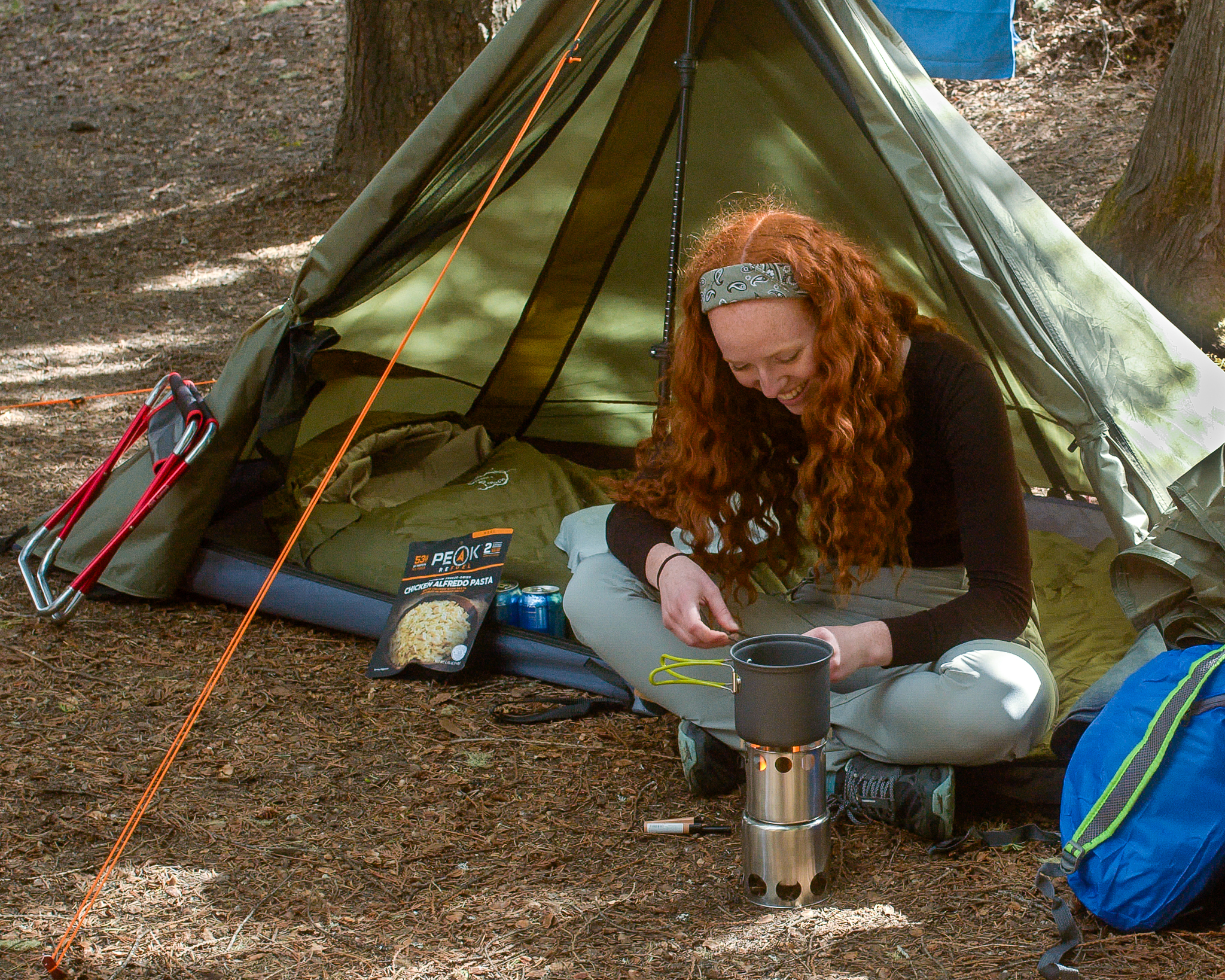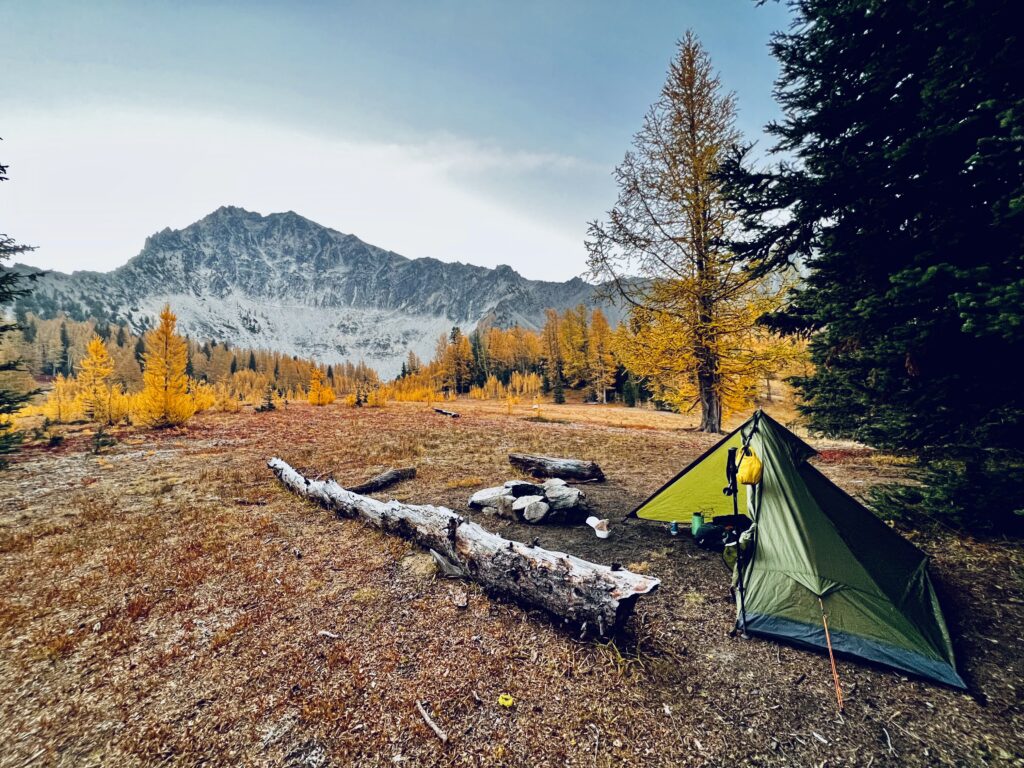
Imagine you’re deep in the wilderness, surrounded by nature’s wonders, and the sun is setting. It’s time to set up camp. Selecting the perfect campsite for your trekking pole tent can transform your outdoor adventure.
Factors for Selecting a Campsite:
- Distance from Water Sources: In the PNW, I came across a breathtaking alpine lake. It was an idyllic spot, and the proximity to water was a boon for hydration and camp chores. However, I remembered the importance of leaving no trace and the need to protect the fragile ecosystem. I chose a campsite that was at least 200 feet away from the lake’s shore, following Leave No Trace principles. Balancing convenience and environmental stewardship was key.
- Terrain and Ground Conditions: I learned the value of level ground. One evening, I stumbled upon a seemingly perfect campsite, but upon closer inspection, I noticed the sloping ground and uneven terrain. These factors would have impacted my sleep and comfort. I decided to continue hiking until I found a level, well-drained spot, avoiding low-lying areas prone to water collection.
- Safety Concerns: I encountered a campsite nestled beneath a rocky outcrop. It seemed picturesque, but signs of recent rockfall made me pause. Safety was paramount, and I opted to move to a safer location, away from potential rockfall hazards. Always be cautious of environmental hazards and local wildlife habits. Avoid areas prone to rockfall, avalanches, or flash floods, and stay clear of places with dead or overhanging trees that could pose a hazard.
- Proximity to Trails: I experienced the convenience of camping near a well-traveled trail. It offered quick access and a sense of community with fellow hikers. However, we always ensured not to obstruct the trail and adhered to camping distances from the path. Following established trails and respecting camping distances are essential for minimizing environmental impact and harmonious sharing of the trail.
- Sun and Wind Exposure: I learned to appreciate the power of the sun. Selecting a campsite that received the morning sun’s warmth not only thawed my tent but also provided a cozy start to the day. Thinking about the sun’s path and prevailing wind direction when choosing your campsite can help regulate temperature and provide a comfortable environment. Paying attention to wind direction can also help you avoid strong gusts and ensure a peaceful night’s sleep.
- Wildlife Considerations: I made sure not to camp near game trails, known animal dens, or areas with high bear activity. Additionally, I followed proper food storage procedures, like using bear canisters or hanging food properly. Respecting wildlife and minimizing human impact is crucial for both your safety and the preservation of natural habitats.
Leave No Trace Principles:
When choosing a campsite and throughout your outdoor adventure, it’s essential to follow Leave No Trace principles. These principles emphasize responsible outdoor ethics:
- Plan ahead and camp in established sites when possible.
- Dispose of waste properly, including human waste. Follow the “pack it in, pack it out” rule for all trash.
- Minimize campfire impact by using a camp stove for cooking and respecting fire regulations.
- Respect wildlife by observing from a distance and not feeding them.
- Be considerate of other visitors and keep noise levels down.

Tips for Setting Up Your Trekking Pole Tent:
- Clear the Area: Prior to pitching your tent, take a moment to clear the campsite of rocks, sticks, and debris. This small effort not only ensures a comfortable night’s sleep but also prevents potential damage to your tent’s floor.
- Use a Ground Cloth or Footprint: Placing a ground cloth or footprint under your tent can protect the tent floor from abrasions and moisture. It’s a valuable addition to your gear that extends the life of your tent.
- Secure Guy Lines: Ensuring your tent’s guy lines are correctly staked and tensioned is essential. This not only adds stability but also helps prevent tripping hazards around your tent. Taut guylines also contribute to improved wind resistance.
- Consider Rainfly Placement: If you anticipate rain or inclement weather, make sure the rainfly is correctly positioned to cover the tent and provide adequate ventilation to reduce condensation inside. Ventilation is vital to minimize moisture buildup inside your tent, particularly during cold, humid conditions.
- Leave No Trace Principles: Follow Leave No Trace principles not only in selecting your campsite but also throughout your camping experience. Remember, it’s all about preserving the beauty of the great outdoors and ensuring future generations can enjoy it.
- Check Local Regulations: Always be aware of specific camping regulations or restrictions in the area you’re backpacking. Some locations may require permits, have guidelines for camping distances from trails or water sources, or prohibit campfires. Staying informed and respecting local regulations is a fundamental aspect of responsible outdoor recreation.
Remember that your campsite choice can significantly impact your overall outdoor experience. Whether you’re deep in the backcountry or at a designated campsite, taking the time to choose a suitable location and properly setting up your trekking pole tent ensures a safe, comfortable night under the stars.
Your trekking pole tent is your ticket to adventure, and your campsite is the stage for unforgettable memories. Choose wisely, respect the environment, and embrace the beauty of the great outdoors.
Stay tuned for more insights on trekking pole tents, outdoor gear and tips for making the most of your backpacking adventures.
